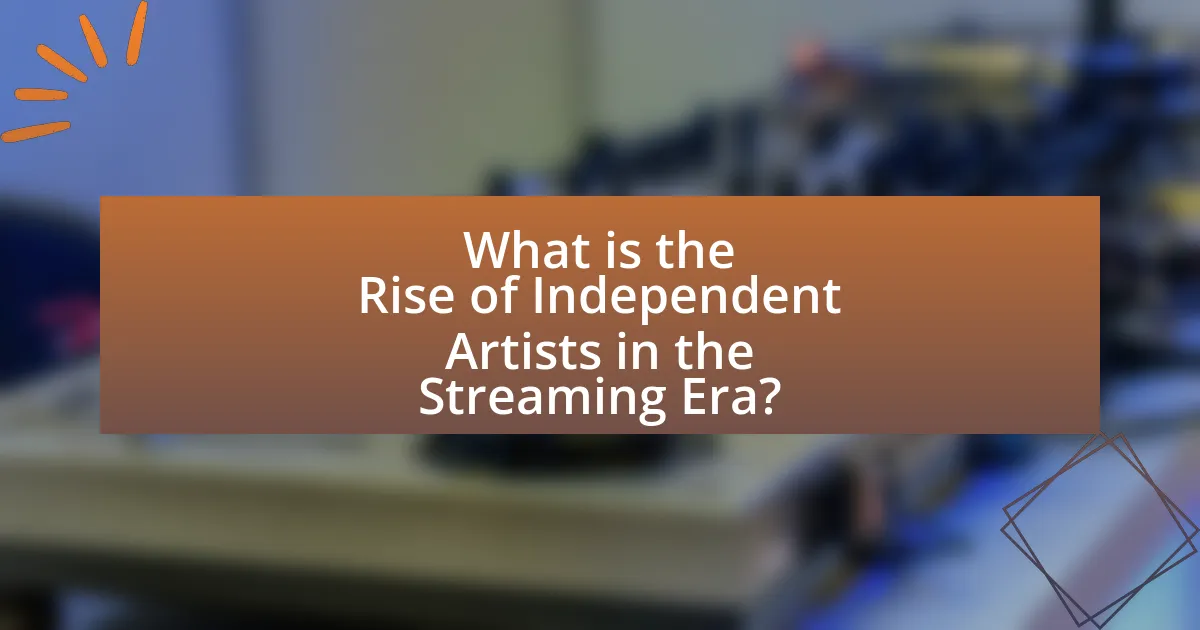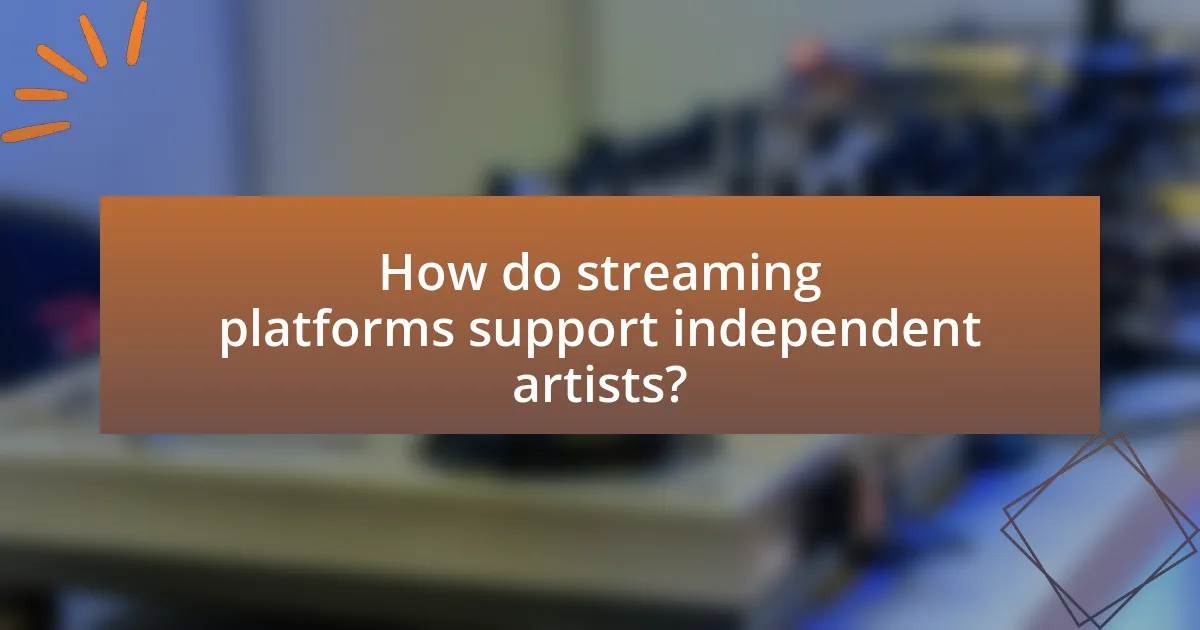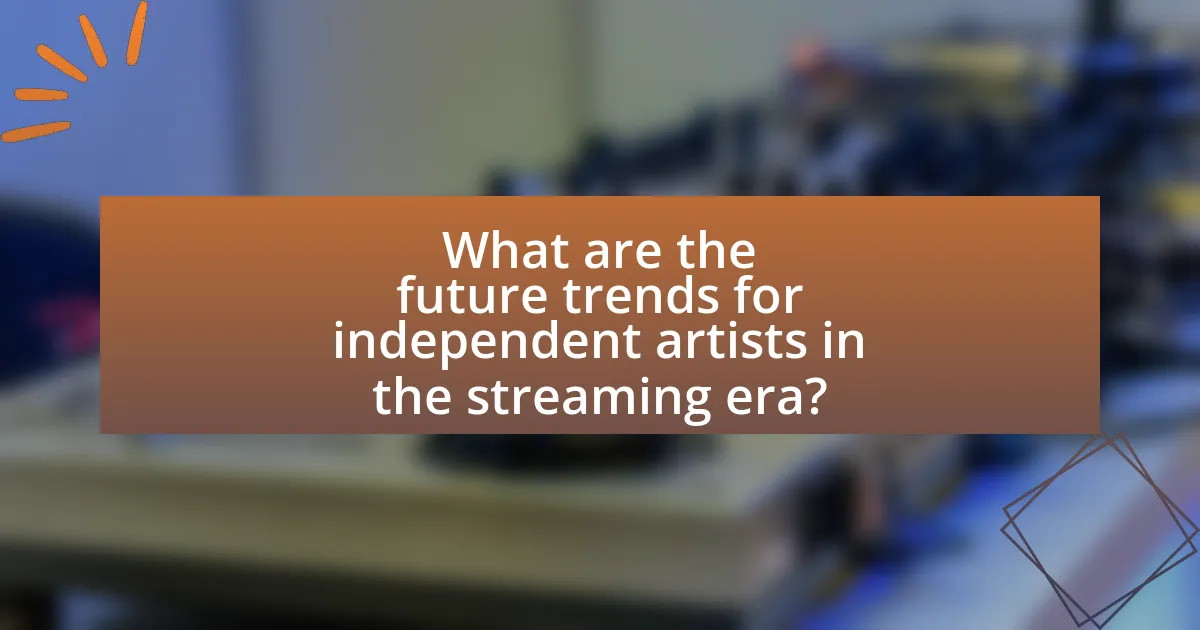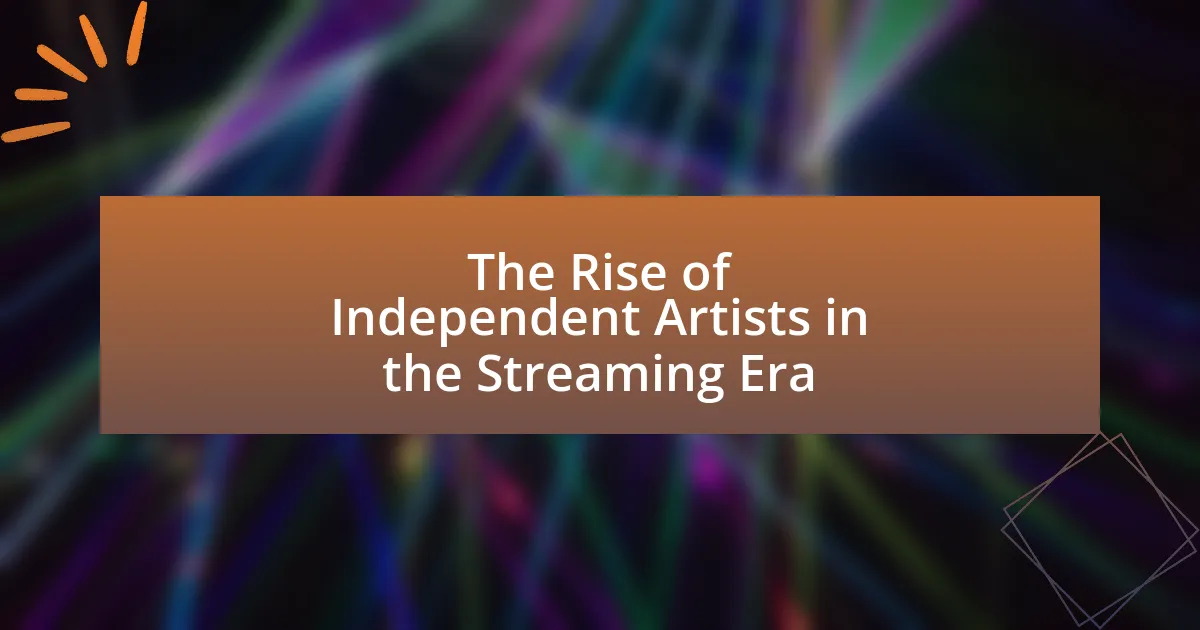The article examines the rise of independent artists in the streaming era, highlighting how digital platforms like Spotify and Apple Music have transformed music distribution by allowing musicians to reach global audiences without major label support. It discusses the significant impact of streaming on the music industry, noting that independent labels accounted for 40% of global recorded music revenue in 2021. Key characteristics of the streaming era, such as accessibility and data-driven content delivery, are explored, along with the challenges independent artists face, including low revenue per stream and competition for visibility. The article also outlines strategies for success, including audience engagement and leveraging analytics, while addressing future trends and innovations in music distribution and promotion.

What is the Rise of Independent Artists in the Streaming Era?
The rise of independent artists in the streaming era refers to the significant increase in the visibility and success of musicians who operate without major label support, primarily due to the accessibility of digital platforms. Streaming services like Spotify, Apple Music, and Bandcamp have democratized music distribution, allowing independent artists to reach global audiences without the traditional barriers imposed by record labels. According to a report by the International Federation of the Phonographic Industry (IFPI), independent labels accounted for 40% of global recorded music revenue in 2021, highlighting the growing influence of these artists in the industry. This shift has enabled independent musicians to retain more control over their creative output and revenue streams, fostering a diverse and vibrant music landscape.
How has the streaming era changed the music industry landscape?
The streaming era has fundamentally transformed the music industry landscape by enabling independent artists to reach global audiences without traditional label support. This shift is evidenced by the rise of platforms like Spotify and Apple Music, which provide artists with direct access to listeners, allowing for greater control over their music distribution and marketing. According to a 2021 report by the International Federation of the Phonographic Industry (IFPI), independent labels accounted for 40% of global recorded music revenues, highlighting the significant impact of streaming on artist autonomy and revenue generation.
What are the key characteristics of the streaming era?
The key characteristics of the streaming era include accessibility, personalization, and data-driven content delivery. Accessibility allows users to access a vast library of music and videos on-demand, often through subscription-based models, which has significantly increased consumption rates. Personalization is achieved through algorithms that recommend content based on user preferences and listening habits, enhancing user engagement. Data-driven content delivery utilizes analytics to inform artists and platforms about audience behavior, enabling targeted marketing and tailored experiences. These characteristics have transformed how music is produced, distributed, and consumed, leading to a rise in independent artists who can reach global audiences without traditional gatekeepers.
How do streaming platforms differ from traditional music distribution?
Streaming platforms differ from traditional music distribution primarily in their delivery method and revenue model. Streaming services provide on-demand access to a vast library of music for a subscription fee or ad-supported model, allowing users to listen to any song at any time. In contrast, traditional music distribution relies on physical sales, such as CDs and vinyl, or digital downloads, where consumers purchase individual tracks or albums outright.
This shift has led to a significant change in how artists earn revenue; streaming platforms typically pay artists per stream, which can result in lower overall earnings compared to the upfront payments from traditional sales. According to a 2021 report by the International Federation of the Phonographic Industry, streaming accounted for 62% of global recorded music revenue, highlighting its dominance over traditional sales methods.
Why are independent artists gaining popularity in this era?
Independent artists are gaining popularity in this era primarily due to the accessibility of digital platforms that allow them to distribute their music without the need for traditional record labels. The rise of streaming services like Spotify and Apple Music has democratized music distribution, enabling independent artists to reach global audiences directly. According to a report by the International Federation of the Phonographic Industry (IFPI), independent labels accounted for 40% of global recorded music revenue in 2021, highlighting their significant market presence. Additionally, social media platforms facilitate direct engagement with fans, allowing independent artists to build loyal followings and promote their work effectively.
What factors contribute to the rise of independent artists?
The rise of independent artists is primarily driven by advancements in technology, particularly digital distribution platforms and social media. These platforms enable artists to reach global audiences without the need for traditional record labels, allowing for greater creative control and financial independence. For instance, services like Spotify and Bandcamp provide artists with tools to distribute their music directly to listeners, while social media platforms like Instagram and TikTok facilitate direct engagement with fans, enhancing visibility and marketing opportunities. According to a report by MIDiA Research, independent artists accounted for 40% of global music revenues in 2021, highlighting the significant impact of these factors on their growth.
How do independent artists leverage streaming platforms for success?
Independent artists leverage streaming platforms for success by utilizing data analytics, engaging directly with fans, and promoting their music through curated playlists. Streaming platforms provide artists with access to listener demographics and engagement metrics, allowing them to tailor their marketing strategies effectively. For instance, platforms like Spotify and Apple Music offer tools that help artists understand which songs resonate with their audience, enabling targeted promotions. Additionally, independent artists can build a loyal fanbase by interacting with listeners through social media and live-streaming events, fostering a sense of community. Furthermore, being featured on popular playlists can significantly increase an artist’s visibility; for example, Spotify’s editorial playlists have been known to boost streams by thousands, leading to higher revenue and opportunities for live performances.
What challenges do independent artists face in the streaming era?
Independent artists face significant challenges in the streaming era, primarily due to low revenue from streaming platforms. According to a 2021 report by the Music Industry Revenue, artists earn an average of $0.003 to $0.005 per stream, making it difficult for them to sustain a living solely from their music. Additionally, independent artists struggle with visibility and competition, as algorithms favor established artists, limiting exposure for newcomers. Furthermore, the lack of marketing resources and industry connections often hinders their ability to promote their work effectively. These factors collectively create a challenging environment for independent artists trying to thrive in the streaming landscape.
What are the common obstacles in marketing and promotion?
Common obstacles in marketing and promotion include limited budgets, lack of industry connections, and oversaturation of the market. Independent artists often face financial constraints that restrict their ability to invest in effective marketing strategies, making it difficult to reach a wider audience. Additionally, without established networks, these artists struggle to gain visibility and credibility in a competitive landscape. The music industry is characterized by a high volume of content, which can dilute individual efforts and make it challenging for new releases to stand out. According to a report by the Music Industry Association, 70% of independent artists cite budget limitations as a primary barrier to effective promotion.
How do financial aspects impact independent artists?
Financial aspects significantly impact independent artists by determining their ability to produce, promote, and distribute their work. Limited financial resources can restrict an artist’s access to quality production tools, marketing strategies, and distribution channels, which are essential for reaching wider audiences. For instance, a study by the Future of Music Coalition found that independent musicians often earn less than their major-label counterparts, with many relying on live performances and crowdfunding to sustain their careers. This financial disparity can lead to challenges in maintaining artistic integrity and pursuing creative projects, as artists may prioritize commercial viability over artistic expression due to financial pressures.

How do streaming platforms support independent artists?
Streaming platforms support independent artists by providing them with accessible distribution channels and monetization opportunities. These platforms, such as Spotify and Bandcamp, allow artists to upload their music directly, bypassing traditional gatekeepers like record labels. This direct access enables independent artists to reach global audiences without significant upfront costs. Additionally, streaming services often offer tools for analytics, helping artists understand their listener demographics and engagement, which can inform marketing strategies. According to a report by the International Federation of the Phonographic Industry (IFPI), independent artists accounted for 39% of global recorded music revenue in 2020, highlighting the financial viability of this model.
What features do streaming platforms offer to independent musicians?
Streaming platforms offer independent musicians features such as distribution services, analytics tools, promotional opportunities, and monetization options. These platforms enable musicians to distribute their music globally, reaching a wider audience without the need for traditional record labels. Analytics tools provide insights into listener demographics and engagement, allowing artists to tailor their marketing strategies effectively. Additionally, many platforms offer promotional features like playlist placements and social media integration, which can significantly enhance visibility. Monetization options, including streaming royalties and merchandise sales, provide independent musicians with revenue streams that support their careers.
How do playlists and algorithms benefit independent artists?
Playlists and algorithms significantly benefit independent artists by increasing their visibility and reach to potential listeners. Streaming platforms utilize algorithms to curate personalized playlists, which can feature independent artists alongside mainstream acts, allowing these artists to gain exposure to wider audiences. For instance, Spotify’s algorithm-driven playlists, such as Discover Weekly, have been shown to boost streams for independent artists, with data indicating that tracks featured in these playlists can experience a 30% increase in plays. This exposure not only enhances their chances of gaining new fans but also improves their chances of securing performance opportunities and collaborations, ultimately contributing to their growth in the competitive music industry.
What role does audience engagement play in an artist’s success?
Audience engagement is crucial for an artist’s success as it directly influences their visibility, fan loyalty, and revenue generation. Engaged audiences are more likely to share an artist’s work, attend live performances, and purchase merchandise, which enhances the artist’s marketability. For instance, a study by Nielsen Music found that artists with high engagement on social media platforms see a 50% increase in streaming numbers compared to those with lower engagement. This demonstrates that active interaction with fans not only builds a community but also translates into tangible success metrics for independent artists in the streaming era.
How can independent artists maximize their presence on streaming platforms?
Independent artists can maximize their presence on streaming platforms by actively engaging with their audience and utilizing data analytics to inform their strategies. Engaging with fans through social media, live streams, and behind-the-scenes content fosters a loyal community, which can lead to increased streams and shares. Additionally, using analytics tools provided by platforms like Spotify for Artists allows artists to understand listener demographics and preferences, enabling targeted marketing efforts. According to a 2021 report by MIDiA Research, independent artists accounted for 40% of global music consumption, highlighting the importance of strategic engagement and data-driven decisions in enhancing visibility on these platforms.
What strategies can artists use to increase their visibility?
Artists can increase their visibility by leveraging social media platforms, engaging with their audience, and collaborating with other creators. Social media allows artists to share their work widely, with platforms like Instagram and TikTok being particularly effective for visual and performance art. Engaging with the audience through live streams, Q&A sessions, and responding to comments fosters a community around the artist, enhancing loyalty and visibility. Collaborating with other artists or influencers can also introduce their work to new audiences, as seen in successful partnerships that have led to increased follower counts and streaming numbers. According to a 2021 report by the International Federation of the Phonographic Industry, artists who actively engage on social media see a 30% increase in fan interaction compared to those who do not.
How important is social media in promoting music on streaming services?
Social media is crucial for promoting music on streaming services, as it significantly enhances visibility and engagement. Platforms like Instagram, TikTok, and Twitter allow artists to connect directly with fans, share content, and create viral moments that drive streams. For instance, a study by the International Federation of the Phonographic Industry (IFPI) found that 70% of music listeners discover new music through social media. This demonstrates that social media not only facilitates direct communication but also serves as a powerful marketing tool that can lead to increased streaming numbers and audience growth for independent artists.

What are the future trends for independent artists in the streaming era?
Future trends for independent artists in the streaming era include increased reliance on direct-to-fan platforms, enhanced use of data analytics for audience engagement, and the rise of decentralized music distribution models. Independent artists are increasingly utilizing platforms like Bandcamp and Patreon to foster direct relationships with their fans, allowing for greater financial independence and creative control. Additionally, data analytics tools are becoming essential for these artists to understand listener preferences and optimize their marketing strategies, as evidenced by the growing number of independent artists leveraging Spotify for Artists and similar services. Furthermore, the emergence of blockchain technology is facilitating decentralized distribution, enabling artists to retain a larger share of their revenue while minimizing the influence of traditional record labels. These trends indicate a shift towards greater autonomy and innovative approaches in the music industry for independent artists.
How is technology shaping the future of independent music?
Technology is significantly shaping the future of independent music by providing artists with accessible tools for creation, distribution, and promotion. Digital audio workstations and affordable recording equipment enable musicians to produce high-quality music without the need for expensive studio time. Platforms like Spotify, Bandcamp, and SoundCloud allow independent artists to distribute their music globally, reaching audiences directly without traditional gatekeepers. Additionally, social media and digital marketing tools empower artists to build their brands and engage with fans, fostering community and loyalty. According to a report by the International Federation of the Phonographic Industry, independent labels accounted for 40% of global recorded music revenue in 2020, highlighting the growing impact of technology on the independent music sector.
What innovations are emerging in music distribution and promotion?
Innovations in music distribution and promotion include the rise of blockchain technology, which enhances transparency and security in transactions, and the use of artificial intelligence for personalized marketing strategies. Blockchain allows artists to receive direct payments and maintain control over their intellectual property, as seen in platforms like Audius. AI-driven tools analyze listener data to create targeted promotional campaigns, improving engagement and reach. Additionally, social media platforms are increasingly integrating music distribution features, enabling artists to share their work directly with audiences, exemplified by TikTok’s influence on music trends and virality. These innovations collectively empower independent artists to navigate the streaming landscape more effectively.
How might listener behavior evolve in the coming years?
Listener behavior is likely to evolve towards increased personalization and engagement with independent artists in the coming years. As streaming platforms enhance their algorithms, listeners will receive more tailored recommendations based on their unique preferences, leading to a deeper connection with independent artists who often rely on niche audiences. Additionally, the rise of social media and direct-to-fan marketing will empower listeners to interact more with artists, fostering community and loyalty. According to a 2022 report by MIDiA Research, 50% of music listeners expressed a preference for discovering new music through social media, indicating a shift towards platforms that facilitate direct artist engagement. This trend suggests that listeners will increasingly seek authentic connections with artists, driving the growth of independent music in the streaming era.
What best practices can independent artists adopt for sustained growth?
Independent artists can adopt several best practices for sustained growth, including building a strong online presence, engaging with their audience, and diversifying revenue streams. A strong online presence, particularly on social media platforms, allows artists to reach wider audiences and showcase their work effectively. Engaging with fans through regular updates, live performances, and interactive content fosters loyalty and community. Diversifying revenue streams, such as through merchandise sales, crowdfunding, and licensing music for media, provides financial stability. According to a 2021 report by the Music Industry Association, independent artists who actively engage with their audience and utilize multiple revenue channels see a 30% increase in overall income compared to those who do not.
How can artists build a loyal fanbase in the streaming era?
Artists can build a loyal fanbase in the streaming era by engaging directly with their audience through social media, consistent content creation, and personalized interactions. Direct engagement allows artists to foster a sense of community, as evidenced by the fact that 70% of fans feel more connected to artists who interact with them online. Consistent content creation, such as regular music releases and behind-the-scenes content, keeps fans invested and eager for more, which is supported by data showing that artists who release music frequently see a 30% increase in fan retention. Personalized interactions, such as responding to comments or hosting live Q&A sessions, enhance the fan experience and build loyalty, as 65% of fans report feeling more loyal to artists who acknowledge them personally.
What are effective ways to monetize music as an independent artist?
Independent artists can effectively monetize music through various channels, including digital sales, streaming platforms, merchandise sales, live performances, and crowdfunding. Digital sales allow artists to sell their music directly to fans via platforms like Bandcamp, where they retain a larger percentage of revenue compared to traditional record labels. Streaming platforms such as Spotify and Apple Music provide exposure and generate income through royalties, although the payout per stream is relatively low.
Merchandise sales, including branded clothing and physical copies of music, can significantly boost income, especially during live shows. Live performances not only generate ticket sales but also create opportunities for merchandise sales and fan engagement. Crowdfunding platforms like Patreon enable artists to receive direct support from fans in exchange for exclusive content, further diversifying income streams.
According to a 2021 report by the Music Industry Association, independent artists earned approximately 60% of their income from live performances and merchandise, highlighting the importance of these revenue streams in the current music landscape.
